Investigation of Spatio-Temporal Simulation of Mining Subsidence and Its Determinants Utilizing the RF-CA Model
Abstract
1. Introduction
2. Methods and Materials
2.1. Methods
2.1.1. Subsidence Data Acquisition Based on InSAR Technology
2.1.2. Driving Factor Correlation Analysis Methods
2.1.3. Simulation of Subsidence Evolution Based on RF-CA Model
- (1)
- Random forest (RF) model
- (2)
- Cellular automata (CA) model
2.1.4. Accuracy Evaluation
2.1.5. Analysis Methods for the Spatio-Temporal Evolution of Subsidence
- (1)
- Kernel density analysis method
- (2)
- Center of gravity model
2.2. Materials
2.2.1. Overview of Study Area
2.2.2. Surface Subsidence Data
2.2.3. Subsidence-Driving Factor Data
3. Results
3.1. Correlation Analysis for Subsidence-Driving Factors
3.2. Analysis of Driving Factors’ Contribution to Subsidence
3.3. Spatial and Temporal Simulation of Mining Subsidence
3.4. Trend Analyses of Spatio-Temporal Evolution of Mining Subsidence
4. Discussion
4.1. Comparison of the Method with Other Model Simulation Results
4.2. Improvements and Extensions of This Research
- (1)
- Improvement of subsidence-driving factor data. Given the complexity of the mining environment and the difficulty of data collection, the driving factor data are still not comprehensive enough. For example, changes in groundwater levels and the existence of faults may also lead to surface subsidence [67]. In the future, we will consider using remote sensing and contacting the staff of relevant departments to obtain more comprehensive data on subsidence-driving factors to improve the accuracy of subsidence simulation.
- (2)
- Construction of multilayer cellular space to simulate subsidence. This model can utilize historical subsidence data to train the random forest model, establish the correspondence between the upper mining workings and subsidence, and formulate cellular conversion rules. Since there are cases where multiple coal seams are mined at the same or different times in the mining area, combining object-oriented methods should be considered to construct a multilayer cellular space [36,68]. The conversion rules of the cellular space are adjusted according to the mining order to realize the simulation of subsidence from multiple coal seams.
- (3)
- Refinement of subsidence-driving factor data. Due to the complex stratigraphic conditions in which coal seams are located, rock formations can be categorized into horizontal, vertical, and thrust faults after structural action [69]. In the future, we could categorize the rock formation of different structures, construct the driving factor dataset separately, and clarify the contribution of the rock formation of different structures to subsidence using this model.
5. Conclusions
- (1)
- After quantitative analysis, it can be seen that the depth–thickness ratio (0.242), the distance to the working face (0.159), the distance to the building (0.150), and the nature of the rock formation (0.147) always play the main driving roles in subsidence development.
- (2)
- From the simulation results, it can be seen that the overall trend of subsidence increased during the period 2019–2026. By 2021, more areas of more serious subsidence and serious subsidence occurred, with a total area transfer of 8.34 km2 and 3.89 km2, respectively. By 2026, the growth trend is predicted to slow down, with a total area transfer of 0.85 km2 and 0.13 km2, respectively. Overall, the subsidence shows a spatial trend towards the east (2.95 km), southeast (3.12 km), and northeast (1.05 km).
- (3)
- Compared with other methods, this method is simple to calculate, and there is no requirement to set a large number of simulation parameters artificially. In terms of simulation accuracy, the OA is 0.83, and the KC is 0.71. Due to the limited acquisition of some of the mining data, the impact factors considered are still insufficient, and the simulation accuracy still needs to be improved. In the context of Yongcheng coalfield in China, this study’s results demonstrate the appropriateness and feasibility of the method. The approach can be used to guide the simulation of mining subsidence for other mining areas and can provide technical support for land use planning and environmental conservation protection in coal-resource-based cities.
Author Contributions
Funding
Data Availability Statement
Acknowledgments
Conflicts of Interest
References
- Li, Y.; Pan, S.; Ning, S.; Shao, L.; Jing, Z.; Wang, Z. Coal measure metallogeny: Metallogenic system and implication for resource and environment. Sci. China Earth Sci. 2022, 65, 1211–1228. [Google Scholar] [CrossRef]
- Wang, X. Consideration of building modernized coal economic system. China Coal 2018, 44, 5–8. [Google Scholar] [CrossRef]
- Wang, S.; Sun, Q.; Geng, J.; Yuan, S.; Jia, H.; Wang, S.; Zhang, W.; Hu, J.; Li, D. Geological Support for Response and Damage Reduction in Earth’s Critical Zone under Coal Mining. Geol. China 2024, 11, 1–22. [Google Scholar] [CrossRef]
- Cheng, S.; Gu, H.; Song, W.; Ai, Y.; Zhang, Y.; Lu, S. Study on the Ecological Disturbance Monitoring in Mining Area Based on Remote Sensing Information: Taking Qian’an City as an Example. Met. Mine 2021, 5, 182–189. [Google Scholar] [CrossRef]
- Dai, G.; Xue, X.; Niu, C.; Xu, K.; Jiang, Z.; Xiao, L.; Liu, M. Disturbance characteristics of coal mining to the eco-phreatic flow field in adjacent regions. J. China Coal Soc. 2019, 44, 701–708. [Google Scholar] [CrossRef]
- Wang, Y. Research Progress and Prospect on Ecological Disturbance Monitoring in Mining Area. Acta Geod. Cartogr. Sin. 2017, 46, 1705–1716. [Google Scholar] [CrossRef]
- Li, Q.; Hu, Z.; Zhang, F.; Guo, Y.; Liang, Y. A Study on Historical Big Data Analysis of Surface Ecological Damage in the Coal Mining Area of Lvliang City Based on Two Mining Modes. Land 2024, 13, 1411. [Google Scholar] [CrossRef]
- Litwiniszyn, J. Stochastic methods in subsidence problems: Proc International Symposium on Modern Mining Technology, Taian, October 1988 P300-305. Publ Taian: Shandong Institute of Mining and Technology, 1988. Int. J. Rock Mech. Mech. Min. 1990, 27, 300–305. [Google Scholar] [CrossRef]
- Álvarez-Fernández, M.I.; González-Nicieza, C. Generalization of the n-k influence function to predict mining subsidence. Eng. Geol. 2005, 80, 1–36. [Google Scholar] [CrossRef]
- Nicieza, C.G.; Fernandez, M.I.A.; Diaz, A.M. The new three-dimensional subsidence influence function denoted by n-k-g. J. Rock. Mech. Mech. Min. 2005, 42, 372–387. [Google Scholar] [CrossRef]
- Behrooz, G.; Kazem, G.; Gang, R.; John, V. Numerical modelling of multistage caving processes: Insights from multi-seam longwall mining-induced subsidence. Int. J. Numer. Anal. Met. 2017, 41, 959–975. [Google Scholar] [CrossRef]
- Alam, A.; Badrul Fujii, Y.; Eidee, S.; Boeut, S.; Rahim, A. Prediction of mining-induced subsidence at Barapukuria longwall coal mine, Bangladesh. Sci. Rep. 2022, 12, 14800. [Google Scholar] [CrossRef] [PubMed]
- Jeon, B.; Jeong, H.; Choi, S.; Jeon, S. Assessment of Subsidence Hazard in Abandoned Mine Area Using Strength Reduction Method. KSCE J. Civ. Eng. 2022, 26, 4338–4358. [Google Scholar] [CrossRef]
- Xu, X.; Zhou, C.; Gong, H.; Chen, B.; Wang, L. Monitoring and Analysis of Land Subsidence in Cangzhou Based on Small Baseline Subsets Interferometric Point Target Analysis Technology. Land 2023, 12, 2114. [Google Scholar] [CrossRef]
- Ferretti, A.; Prati, C.; Rocca, F. Permanent scatterers in SAR interferometry. IEEE Trans. Geosci. Remote Sens. 2001, 39, 8–20. [Google Scholar] [CrossRef]
- Blachowski, J.; Milczarek, W.; Grzempowski, P. Application of psinsar for assessment of surface deformations in post-mining area-case study of the former walbrzych hard coal basin (sw poland). Acta Geodyn. Geomater. 2017, 14, 41–52. [Google Scholar] [CrossRef]
- Zhang, W.; Zhang, T.; Zhang, F. Identification of ground subsidence in goaf of Hancheng Mining Area based on PS-InSAR and DS-InSAR. Saf. Coal Mines 2022, 53, 194–199. [Google Scholar] [CrossRef]
- Yang, X.; Niu, Y.; Zhang, Z.; Zhang, P.; Liu, K.; Zhang, L. Research on subsidence monitoring of SBAS-InSAR mining area based on UAV DEM fusion: A case study of a mining area in Wu’an. Prog. Geophys. 2024, 39, 0038–0047. [Google Scholar] [CrossRef]
- Wang, X.; Du, Y.; Jiang, J.; Zhao, F.; Yan, S. Monitoring of temporal and spatial evolution of surface deformation in Yuncheng Mining Area with DS-InSAR. Saf. Coal Mines 2021, 52, 120–125. [Google Scholar] [CrossRef]
- Yang, Y.; Zhang, S.; Hou, H.; Li, X. The Ecological Impacts of Coal Mining and the Regional Differentiation. China Land Sci. 2015, 29, 55–62. [Google Scholar] [CrossRef]
- Arsanjani, J.; Helbich, M.; Kainz, W.; Boloorani, A. Integration of logistic regression, Markov chain and cellular automata models to simulate urban expansion. Int. J. Appl. Earth Obs. 2013, 21, 265–275. [Google Scholar] [CrossRef]
- Chen, Y.; Li, X.; Liu, X.; Ai, B. Modeling urban land-use dynamics in a fast developing city using the modified logistic cellular automaton with a patch-based simulation strategy. Int. J. Geogr. Inf. Sci. 2014, 28, 234–255. [Google Scholar] [CrossRef]
- Tang, Z.; Mei, Z.; Liu, W.; Xia, Y. Identification of the key factors affecting Chinese carbon intensity and their historical trends using random forest algorithm. J. Geogr. Sci. 2020, 30, 743–756. [Google Scholar] [CrossRef]
- Zhou, J.; Chen, K.; Yan, X.; Xu, J.; Yan, C.; Feng, H.; Li, Z. Automatic extraction method of loess erosion gullies based on BP neural network. J. Spatio-Temp. Inf. 2023, 30, 193–201. [Google Scholar] [CrossRef]
- Liu, X.; Liang, X.; Li, X.; Xu, X.; Ou, J.; Chen, Y.; Li, S.; Wang, S.; Pei, F. A future land use simulation model (FLUS) for simulating multiple land use scenarios by coupling human and natural effects. Landsc. Urban Plan. 2017, 168, 94–116. [Google Scholar] [CrossRef]
- Liang, X.; Liu, X.; Li, D.; Zhao, H.; Chen, G. Urban growth simulation by incorporating planning policies into a CA-based future land-use simulation model. Int. J. Geogr. Inf. Sci. 2018, 32, 2294–2316. [Google Scholar] [CrossRef]
- Liu, X.; Pei, F.; Wen, Y.; Li, X.; Liu, Z. Global urban expansion offsets climate-driven increases in terrestrial net primary productivity. Nat. Commun. 2019, 10, 5558. [Google Scholar] [CrossRef]
- Liang, X.; Guan, Q.; Clarke, K.; Liu, S.; Yao, Y. Understanding the drivers of sustainable land expansion using a patch-generating land use simulation (PLUS) model: A case study in Wuhan, China. Comput. Environ. Urban 2021, 85, 101569. [Google Scholar] [CrossRef]
- Liang, X.; Tian, H.; Li, X.; Huang, J.; Clarke, K.; Yao, Y.; Guan, Q.; Hu, G. Modeling the dynamics and walking accessibility of urban open spaces under various policy scenarios. Landsc. Urban Plan. 2021, 207, 103993. [Google Scholar] [CrossRef]
- Wang, K.; Xiao, X.; Yu, Y.; Jia, Q.; Zhao, S. Hybrid prediction model of surface subsidence deformation using CEEMDAN-CNNBiLSTM. J. Navig. Position. 2024, 12, 156–163. [Google Scholar] [CrossRef]
- Liu, J.; Sun, X.; Chen, G.; Li, S.; Jia, P.; Chen, C. Tunnel Vault Settlement Prediction Based on Spatiotemporal Characteristics. J. Xuzhou Inst. Technol. Nat. Sci. Ed. 2024, 39, 11–17. [Google Scholar] [CrossRef]
- Koreen, M.; Murray, R. On the importance of training data sample selection in random forest image classification: A case study in peatland ecosystem mapping. Remote Sens. 2015, 7, 8489–8515. [Google Scholar] [CrossRef]
- Silvia, V.; David, M.; Jordi, I. Production of a dynamic cropland mask by processing remote sensing image series at high temporal and spatial resolutions. Remote Sens. 2016, 8, 55. [Google Scholar] [CrossRef]
- Yang, J.; Hu, T.; Li, B.; Li, D.; Zhang, J.; Huang, Q.; Ge, B.; Bai, T. Spatial and Temporal Evolution Characteristic of Ecological Sensitivity of Dianchi Lake Basin Based on CA-MC Model. J. Yunnan Agric. Univ. (Nat. Sci.) 2023, 38, 894–906. [Google Scholar] [CrossRef]
- Zhang, D.; Liu, X.; Yao, Y.; Zhang, J. Simulating Spatiotemporal Change of Multiple Land Use Types in Dongguan by Using Random Forest Based on Cellular Automata. Geogr. Geo-Inf. Sci. 2016, 32, 22–28. [Google Scholar]
- Chen, Q.; Li, J.; Hou, E. Dynamic simulation for the process of mining subsidence based on cellular automata model. Open Geosci. 2020, 12, 832–839. [Google Scholar] [CrossRef]
- He, C.; Okada, N.; Zhang, Q.; Shi, P.; Li, J. Modelling dynamic urban expansion processes incorporating a potential model with cellular automata. Landsc. Urban Plan. 2008, 86, 79–91. [Google Scholar] [CrossRef]
- El Kamali, M.; Papoutsis, I.; Loupasakis, C.; Abuelgasim, A.; Omari, K.; Kontoes, C. Monitoring of land surface subsidence using persistent scatterer interferometry technology and ground truth data in arid and semi-arid regions, the case of Remah, UAE. Sci. Total Environ. 2021, 776, 145946. [Google Scholar] [CrossRef]
- Berardino, P.; Fornaro, G.; Lanari, R.; Sansosti, E. A new algorithm for surface deformation monitoring based on small baseline differential SAR interferograms. IEEE Trans. Geosci. Remote Sens. 2002, 40, 2375–2383. [Google Scholar] [CrossRef]
- Ma, D.; Guan, Y.; Zhao, S. Monitoring of Surface Deformation in Xi-shan Coalfield Area of Shanxi Province Based on SBAS-InSAR Technology. Coal Technol. 2021, 40, 130–135. [Google Scholar] [CrossRef]
- Xu, J.; Yan, C.; Boota, M.; Chen, X.; Li, Z.; Liu, W.; Yan, X. Research on automatic identification of coal mining subsidence area based on InSAR and time series classification. J. Clean. Prod. 2024, 470, 143293. [Google Scholar] [CrossRef]
- Zhu, J.; Li, Z.; Hu, J. Research Progress and Methods of InSAR for Deformation monitoring. Acta Geod. Cartogr. Sin. 2017, 46, 1717–1733. [Google Scholar] [CrossRef]
- Liu, L.; Wang, Z.; Liang, Z.; Liu, Y. Importance analysis of building components for earthquake losses based on the random forest algorithm. Earthq. Eng. Eng. Dyn. 2024, 44, 70–78. [Google Scholar]
- Guo, R.; Wu, T.; Wu, X.C.; Luigi, S.; Wang, Y.Q. Simulation of urban land expansion under ecological constraints in Harbin-Changchun urban agglomeration, China. Chin. Geogr. Sci. 2022, 32, 438–455. [Google Scholar] [CrossRef]
- Zhou, L.; Dang, X.; Sun, Q.; Wang, S. Multi-scenario simulation of urban land change in Shanghai by random forest and CA-Markov model. Sustain. Cities Soc. 2020, 55, 102045. [Google Scholar] [CrossRef]
- Biau, G.; Scornet, E. A Random Forest Guided Tour. arXiv 2015. [Google Scholar] [CrossRef]
- Kavzoglu, T.; Teke, A. Predictive Performances of ensemble machine learning algorithms in landslide susceptibility mapping using random forest, extreme gradient boosting (XG Boost) and natural gradient boosting (NG Boost). Arab. J. Sci. Eng. 2022, 47, 7367–7385. [Google Scholar] [CrossRef]
- Jiang, Z.; Wang, M.; Liu, K. Comparisons of convolutional neural network and other machine learning methods in landslide susceptibility assessment: A case study in Pingwu. Remote Sens. 2023, 15, 798. [Google Scholar] [CrossRef]
- Hu, L.; Yan, C. Evaluation of Landslide Susceptibility of Mangshan Mountain in Zhengzhou Based on GWO-1D CNN Model. Sustainability 2024, 16, 5086. [Google Scholar] [CrossRef]
- Chen, X.; Wang, Z.; Yang, H.; Ford, A.; Dawson, R. Enhanced urban growth modelling: Incorporating regional development heterogeneity and noise reduction in a cellular automata model—A case study of Zhengzhou, China. Sustain. Cities Soc. 2023, 99, 104959. [Google Scholar] [CrossRef]
- Brendel, A.; Ferrelli, F.; Piccolo, M.; Perillo, G. Assessment of the effectiveness of supervised and unsupervised methods: Maximizing land-cover classification accuracy with spectral indices data. J. Appl. Remote Sens. 2019, 13, 014503. [Google Scholar] [CrossRef]
- Zhan, Y.; Shakir, M.; Hao, P.; Niu, Z. The effect of EVI time series density on crop classification accuracy. Optik 2017, 157, 1065–1072. [Google Scholar] [CrossRef]
- Huang, W.; Li, Q.; Jing, W.; Ge, Y.; Dong, P.; Fan, L. Diagnostic Performance of Artificial Intelligence on Benign andMalignant Pulmonary Nodules Under Different WHO Pathological Classifications of Lung Cancer. J. Clin. Radiol. 2025, 44, 76–82. [Google Scholar]
- Chen, H.; Xu, H.; Li, X.; Mei, X. Research on saliency target recognition in low light images based on dual branch convolutional neural networks. Laser J. 2024, 45, 136–140. [Google Scholar] [CrossRef]
- Di, Q.; Chen, X.; Wang, M. Spatiotemporal differences and evolutionary trends of coastal marine ecological welfare performance in China. Mar. Sci. Bull. 2022, 41, 302–314. [Google Scholar] [CrossRef]
- Ma, G.; Liu, T.; Zhang, G. Spatial Evolution and Motivation of Ningbo’s Marine Industry Considering Sub-industries. Geogr. Geo-Inf. Sci. 2024, 40, 141–152. [Google Scholar]
- Tang, R.; Li, F. Spatiotemporal evolution of cultivated land on basin scale. J. Water Resour. Water Eng. 2024, 35, 87–197. [Google Scholar] [CrossRef]
- Lei, T.; Wan, S.; Wu, Y.; Wang, H.; Hsieh, C. Multi-temporal data fusion in MS and SAR Images using the dynamic time warping method for paddy rice classification. Agriculture 2022, 12, 77. [Google Scholar] [CrossRef]
- Feng, J.; Yang, Z.; Xu, Y.; Chen, H. Land subsidence monitoring in coal mining collapse area of Urumqi. GNSS World China 2023, 48, 44–51. [Google Scholar] [CrossRef]
- Zhang, S.; Zhao, P.; Wang, N.; Zhao, S.; Li, L.; Song, R.; Zhao, W.; Ma, L. Subsidence monitoring of Huainan coal mining area based on Sentinel-1 data integration of DInSAR and SBAS. Chin. J. Geol. 2023, 58, 1521–1534. [Google Scholar] [CrossRef]
- Gao, J.; Chen, B.; Feng, Z. A Maximum Detectable Deformation Gradient Model of InSAR Technique for Mining Subsidence. Met. Mine 2020, 03, 168–176. [Google Scholar] [CrossRef]
- Li, Q.; Li, G.; Yang, Z. Study on the influence of the depth/thickness ratio on the ground deformation. In Proceedings of the 2011 International Conference on Consumer Electronics, Communications and Networks (CECNet), Xianning, China, 16–18 April 2011; pp. 1730–1733. [Google Scholar]
- Guo, W.; Ma, Z.; Bai, E. Current status and prospect of coal mining technology under buildings, water bodies and railways, and above confined water in China. Coal Sci. Technol. 2020, 48, 16–26. [Google Scholar] [CrossRef]
- Guo, W.; Hu, Y.; Hu, C.; Li, L.; Wu, D.; Ge, Z. System and engineering practice of coal mining technology under buildings, water bodies and railways in China. Coal Sci. Technol. 2024, 9, 1–21. [Google Scholar] [CrossRef]
- Sun, Q.; Chen, Q.; Mu, Y.; Li, H. Probability integral method for fully mechanized mining in shallow coal seam. Coal Eng. 2023, 55, 146–150. [Google Scholar]
- Wang, S.; Geng, J.; Li, P.; Sun, Q.; Fan, Z.; Li, D. Construction of geological guarantee system for green coal mining. Coal Geol. Explor. 2023, 51, 33–43. [Google Scholar] [CrossRef]
- Huang, X. Study on the Development of Land Resources in Mine Subsidence Area. Master’s Thesis, Henan University, Kaifeng, China, 2015. [Google Scholar]
- Chen, Q. Simulation of Coal Mining Subsidence Based on the Model of Cellular Automata. Sci. Technol. Rev. 2013, 31, 65–67. [Google Scholar]
- Guo, L.; Kang, X. Study on the stress evolution law of surrounding rock in fault-bearing coal seam group mining. Coal Techn. 2021, 40, 8–11. [Google Scholar] [CrossRef]
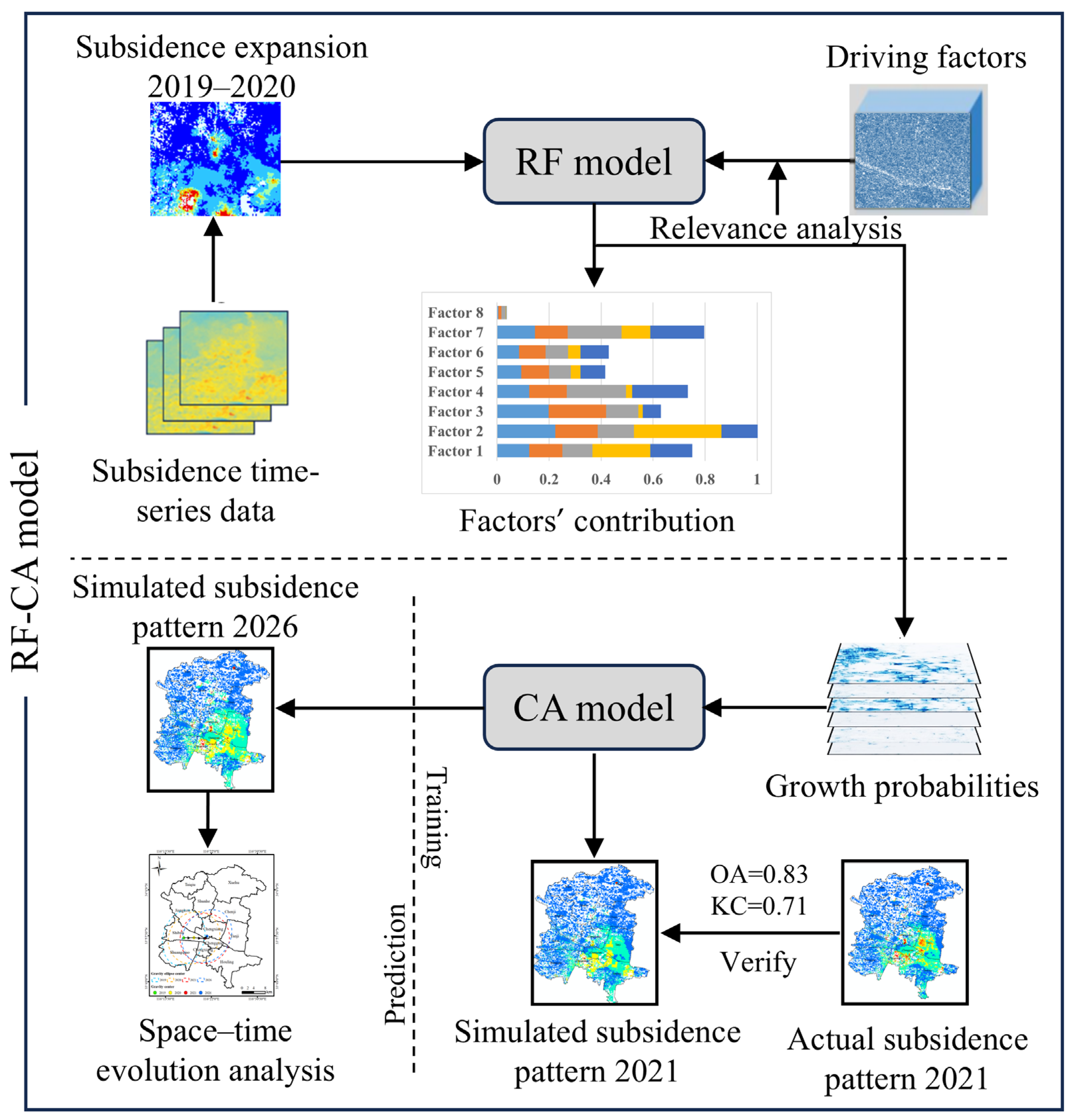
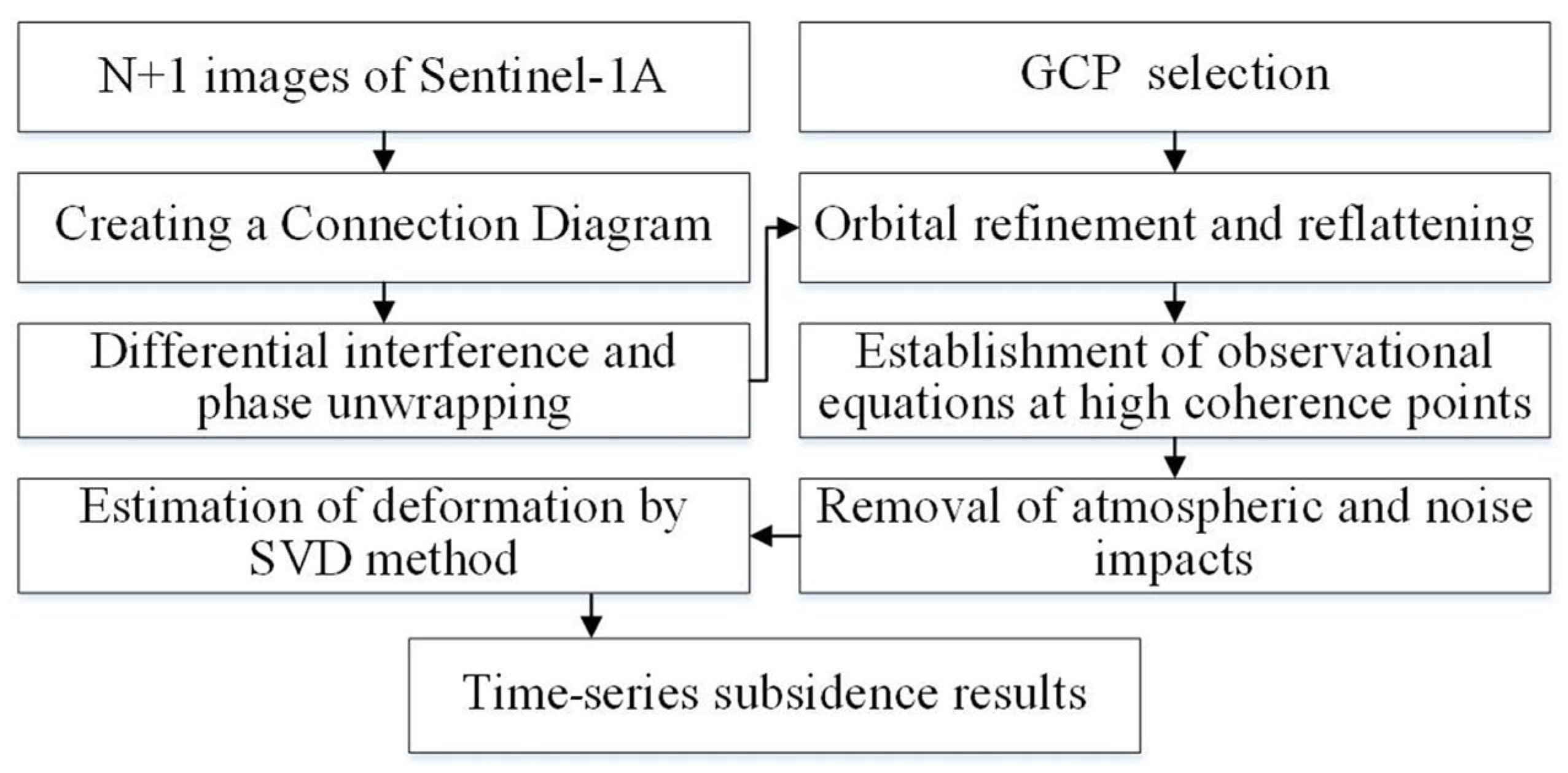
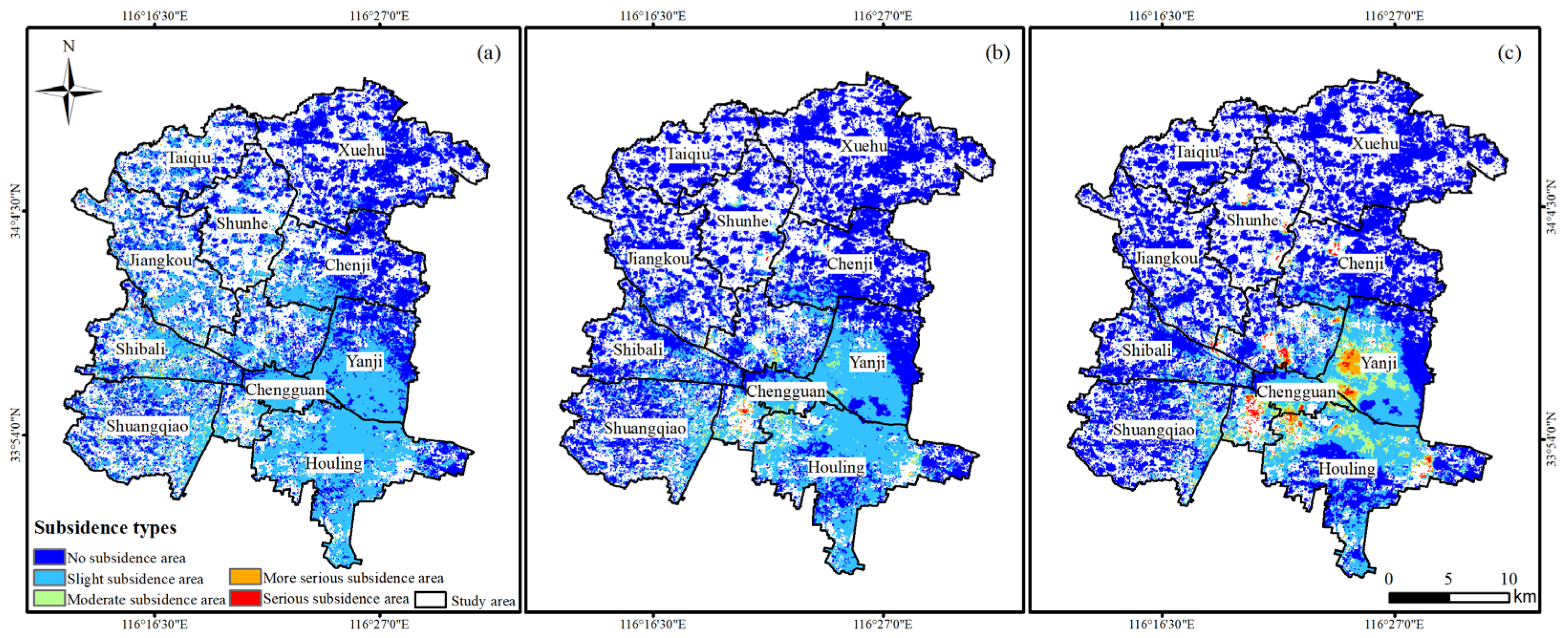
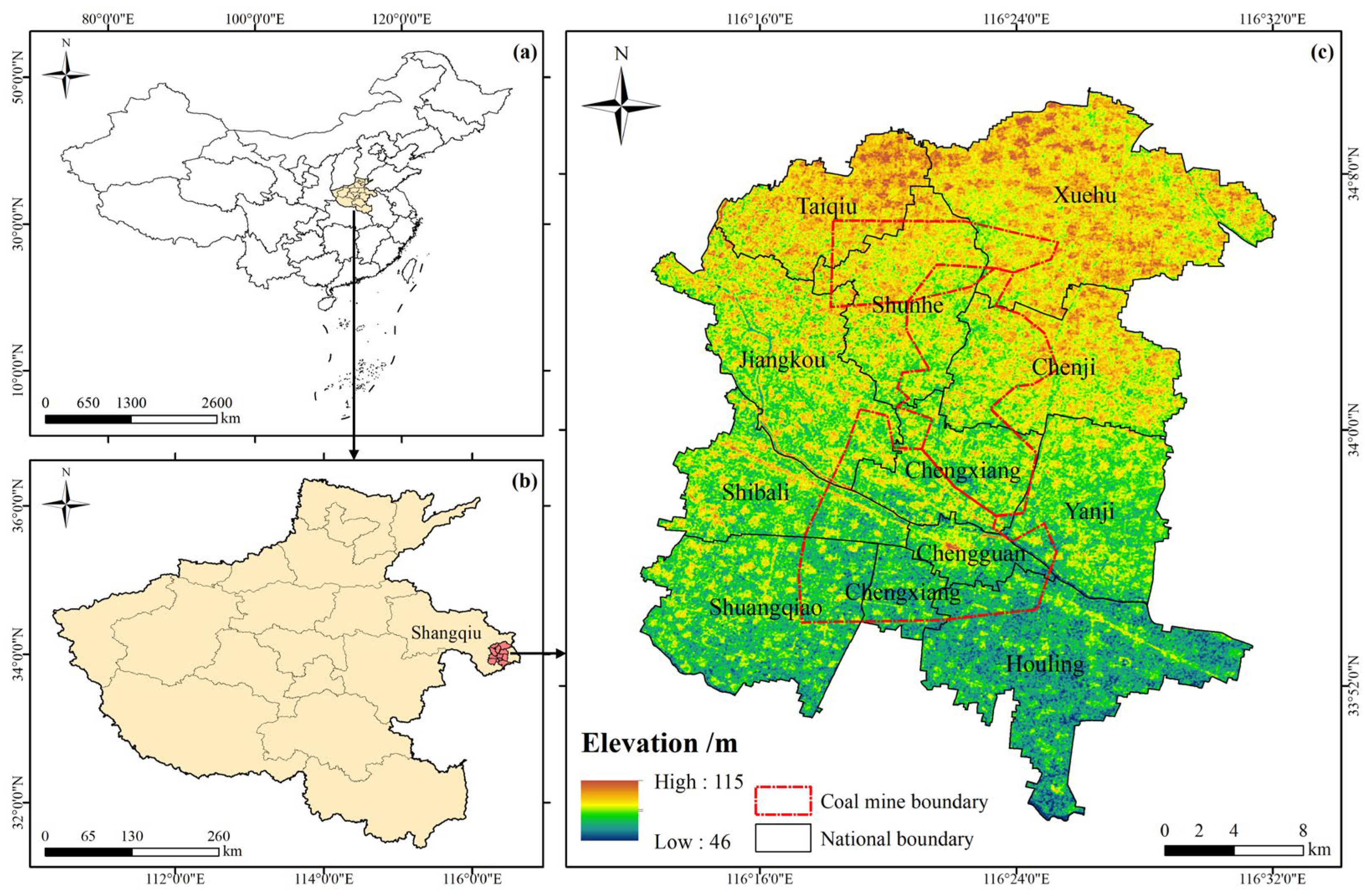


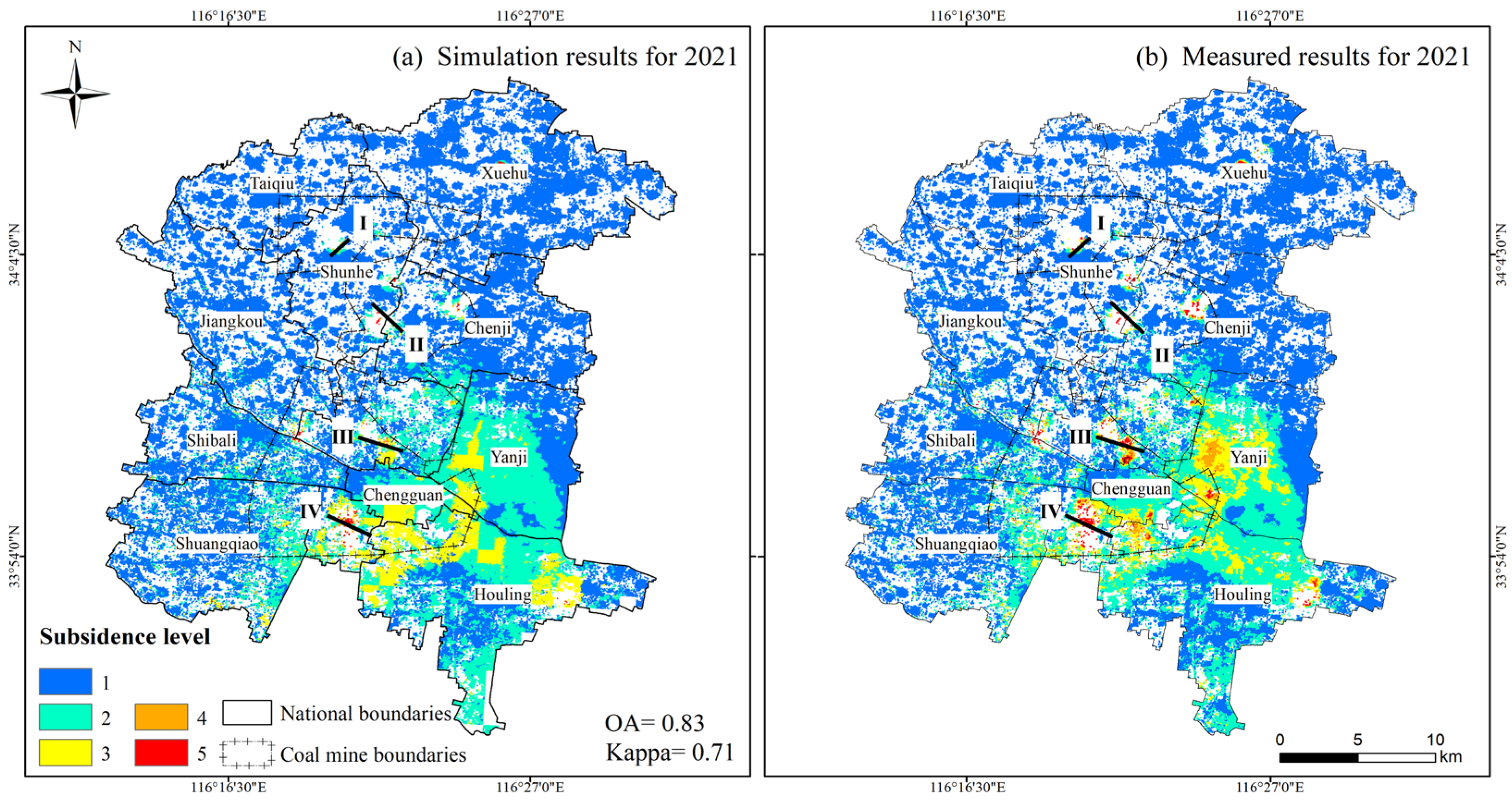
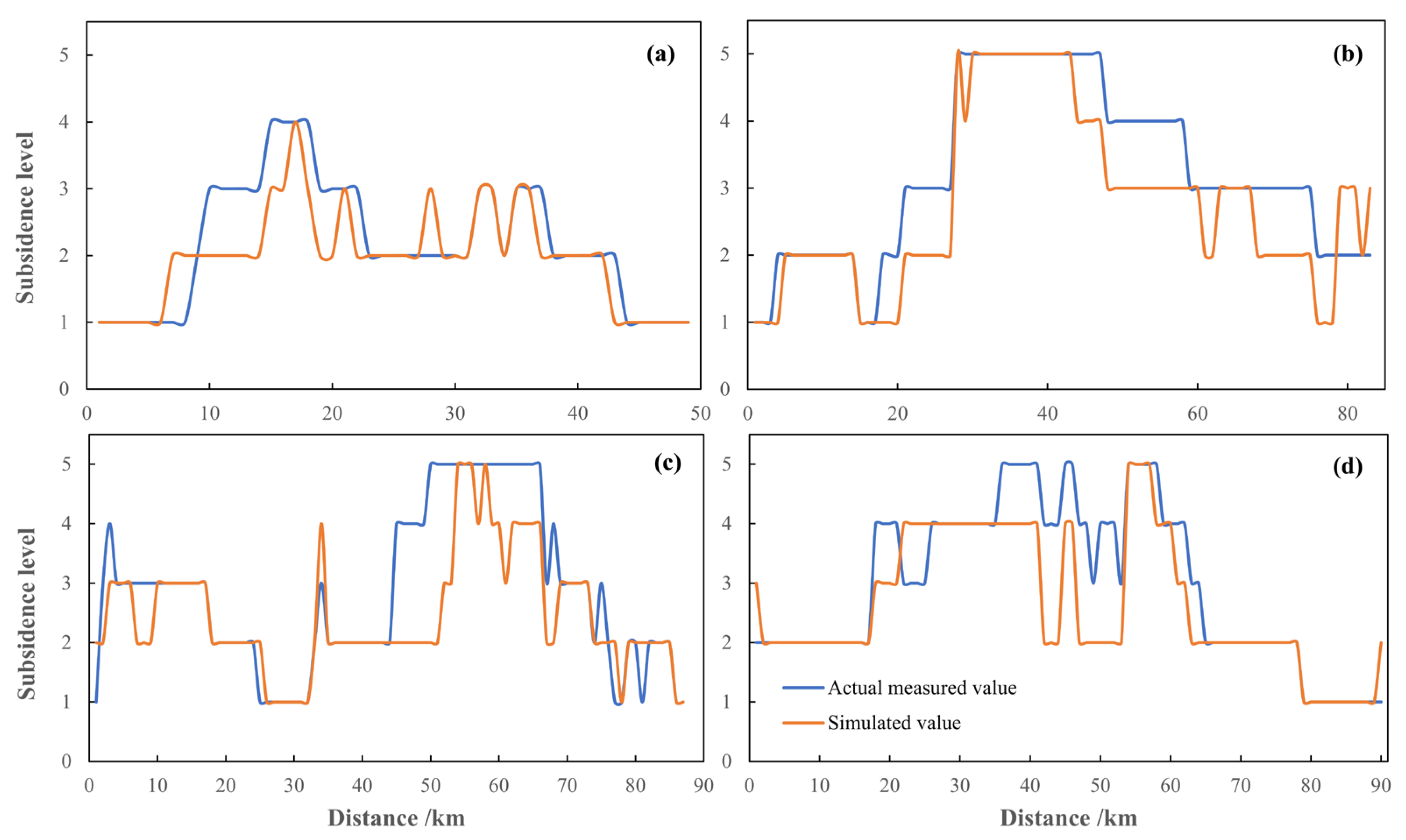

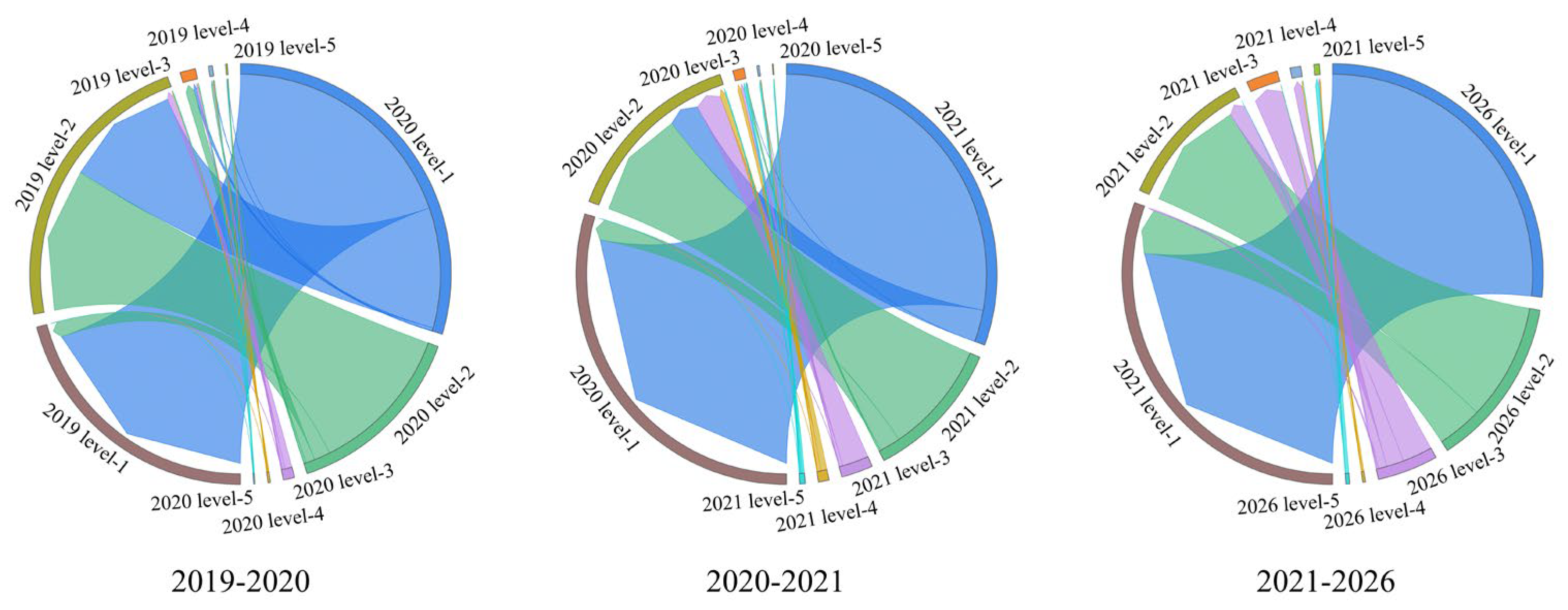
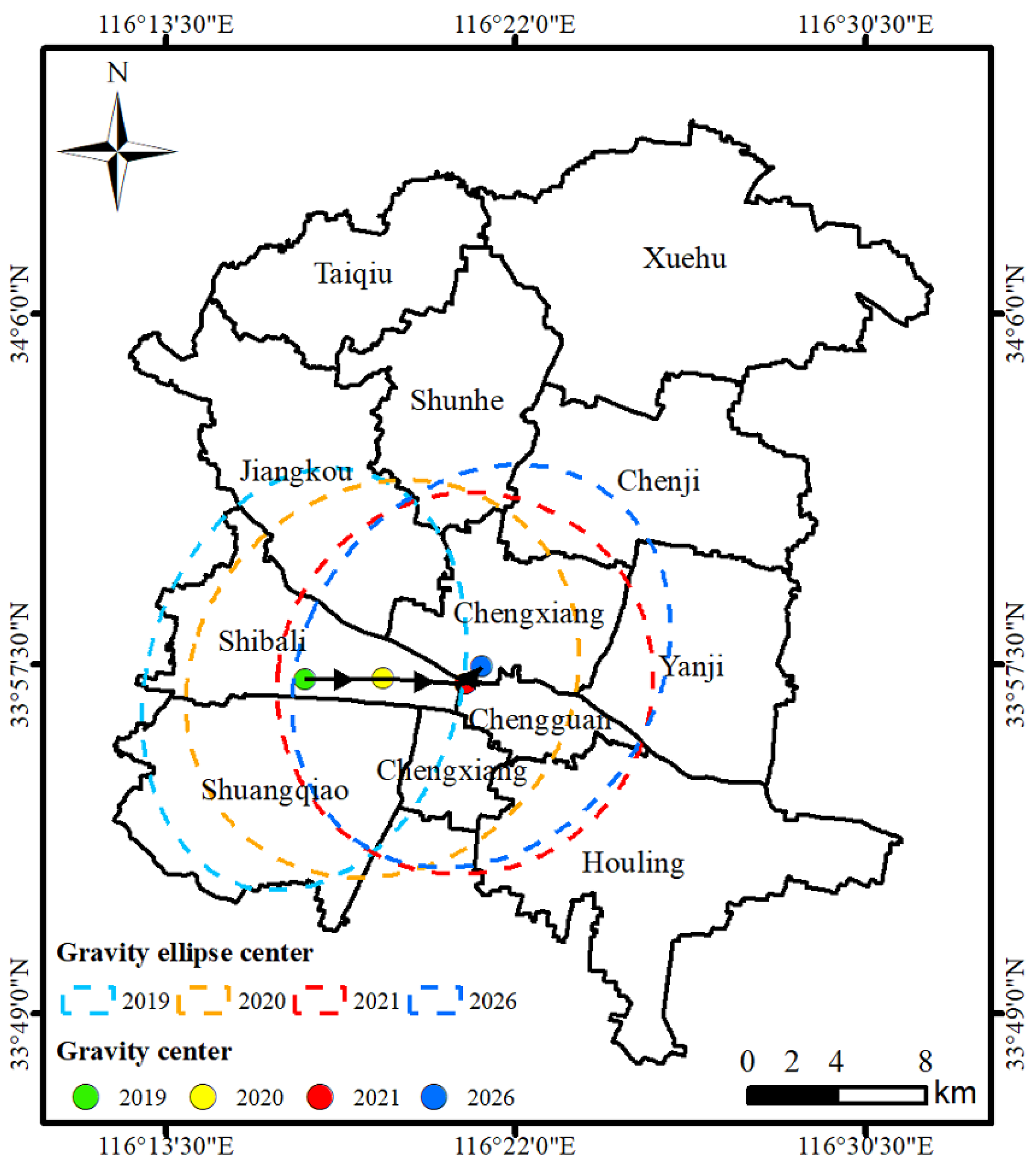

| Types | Driving Factor Data | Data Source |
|---|---|---|
| Mining geological factors | Depth–thickness ratio | A coal mine in Henan Province, China |
| Distance to working face | ||
| Lithologic | ||
| Natural environmental factors | Distance to water | Landsat 8 image classification |
| Distance to building | ||
| Distance to railroad | Administrative division data | |
| Rainfall | National Tibetan Plateau Science Data Center | |
| Slope | Calculated from DEM (https://www.gscloud.cn/) (accessed on 15 January 2024) |
| Driving Factors | ||
|---|---|---|
| Distance to working face | 0.034 | 29.412 |
| Depth–thickness ratio | 0.031 | 32.258 |
| Lithologic | 0.030 | 33.333 |
| Distance to building | 0.029 | 34.483 |
| Distance to railroad | 0.039 | 25.641 |
| Distance to water | 0.044 | 22.727 |
| Rainfall | 0.028 | 35.714 |
| Slope | 0.024 | 41.667 |
Disclaimer/Publisher’s Note: The statements, opinions and data contained in all publications are solely those of the individual author(s) and contributor(s) and not of MDPI and/or the editor(s). MDPI and/or the editor(s) disclaim responsibility for any injury to people or property resulting from any ideas, methods, instructions or products referred to in the content. |
© 2025 by the authors. Licensee MDPI, Basel, Switzerland. This article is an open access article distributed under the terms and conditions of the Creative Commons Attribution (CC BY) license (https://creativecommons.org/licenses/by/4.0/).
Share and Cite
Xu, J.; Yan, C.; Zhang, B.; Chen, X.; Yan, X.; Wang, R.; Yu, B.; Boota, M.W. Investigation of Spatio-Temporal Simulation of Mining Subsidence and Its Determinants Utilizing the RF-CA Model. Land 2025, 14, 268. https://doi.org/10.3390/land14020268
Xu J, Yan C, Zhang B, Chen X, Yan X, Wang R, Yu B, Boota MW. Investigation of Spatio-Temporal Simulation of Mining Subsidence and Its Determinants Utilizing the RF-CA Model. Land. 2025; 14(2):268. https://doi.org/10.3390/land14020268
Chicago/Turabian StyleXu, Jikun, Chaode Yan, Baowei Zhang, Xuanchi Chen, Xu Yan, Rongxing Wang, Binhang Yu, and Muhammad Waseem Boota. 2025. "Investigation of Spatio-Temporal Simulation of Mining Subsidence and Its Determinants Utilizing the RF-CA Model" Land 14, no. 2: 268. https://doi.org/10.3390/land14020268
APA StyleXu, J., Yan, C., Zhang, B., Chen, X., Yan, X., Wang, R., Yu, B., & Boota, M. W. (2025). Investigation of Spatio-Temporal Simulation of Mining Subsidence and Its Determinants Utilizing the RF-CA Model. Land, 14(2), 268. https://doi.org/10.3390/land14020268





